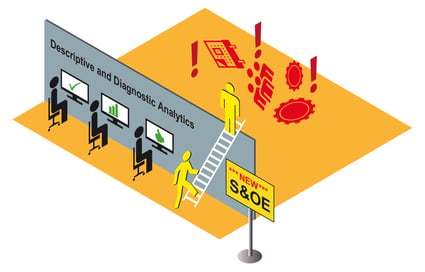Is It Time for S&OE to Move Beyond Descriptive and Diagnostic Analytics?
Kristin Masters - February 14, 2017

 How can organizations get the most out of their Sales and Operations Planning (S&OP) efforts? By establishing a separate Sales and Operations Execution (S&OE) process that focuses on short-term performance and supports the long-term goals of S&OP. While the S&OP team usually looks ahead by up to 18 months, the S&OE team concentrates on the next zero to three months.
How can organizations get the most out of their Sales and Operations Planning (S&OP) efforts? By establishing a separate Sales and Operations Execution (S&OE) process that focuses on short-term performance and supports the long-term goals of S&OP. While the S&OP team usually looks ahead by up to 18 months, the S&OE team concentrates on the next zero to three months.
Thus the S&OP and S&OE teams will pay close attention to different sets of supply chain metrics. For example, S&OP professionals might often consider the rate of new product introduction, which is how rapidly a new product can be brought to market based on design, development and manufacturing times. This metric assists with long-term production cycle planning.
S&OE Takes the Pulse of the Supply Chain
And although the S&OE team should certainly be aware of the rate of new product introduction, this metric doesn't generally figure into daily supply chain activity. Instead, S&OE professionals keep a close eye on the following metrics:
- Future unit volumes: The number of units that can be produced in the near future
- Manufacturing cycle time: The time it takes to produce each item or volume of items, from order release to finished product
- Supplier quantity incoming: The amount of high-quality, usable raw materials arriving from a given supplier
- Throughput: How much of an item is produced by a machine, line, or plant over a specified period
- Capacity utilization: How much of the total manufacturing capacity is actually being used at a given time
- Downtime in proportion to operating time: The ratio of downtime to production time, which directly indicates asset availability
- Changeover speed: The time it takes to switch a manufacturing line or plant from producing one item to producing another
- Yield: The percentage of products manufactured according to specification
- On-time delivery to commit: The percentage of times that products are delivered at the time promised to customers
- Total cost per unit: The sum of all possibly controllable costs for producing a given item or volume; it may also be calculated excluding material costs
These metrics, along with others an S&OE team monitors, all provide critical insights into both supply and demand. They also provide information about the overall profitability of the supply chain. Data management is a critical function for effective S&OE.
Advanced Analytics for S&OE
The metrics listed above should be familiar to any supply chain manager; they're generally considered key performance indicators. Although they offer useful insights, they don't give S&OE leaders the kind of robust data necessary to proactively manage a supply chain. Furthermore, S&OE should feed into S&OP, meaning that the S&OE team cannot solely focus on the immediate. They must pay attention to what's happening in real time — for the purpose of attaining longer-term goals and projections.
Advanced analytics offer the best means for achieving both these functions. What are advanced analytics, exactly? Unlike the descriptive and diagnostic analytics that most supply chain leaders already employ (such as those listed above), advanced analytics are either predictive or prescriptive; that is, they provide insights about the future.
- Predictive analytics enable network simulation, along with supplier risk management. Both machine learning and casual forecasting fall into the category of predictive analytics.
- Prescriptive analytics includes replanning, stochastic and deterministic optimizations. These analytics are incredibly useful for proactive inventory management and factory scheduling.
While integrating advanced analytics can be a difficult process, it's worth the effort. The S&OE team can use advanced analytics to improve product quality, reduce inventory costs and shorten the order cycle. Meanwhile the S&OP team can use advanced analytics for more long-term forecasting, resulting in more efficient product launches and increased revenue.
The first step in leveraging advanced analytics is to ensure that S&OE and S&OP actually exist as separate yet closely aligned business functions. Once these processes have been clearly defined, then advanced analytics — and all other supply chain logistics strategies, for that matter — should support and enhance this framework.
If manufacturing organizations wish to stay competitive and relevant, they must move beyond the analytics of yesterday. While these descriptive and diagnostic analytics still bring great value, they are no longer sufficient. Implementing advanced analytics will give both S&OE and S&OP a robust new toolkit for improving the supply chain's efficiency, visibility and profitability.
LATEST POSTS
- Understand Circular Economy in The Manufacturing Industry
- How Can Industry 4.0 IT Integration Be Achieved Smoothly?
- The Significance of Order Sequencing in Discrete Manufacturing
- How to improve your Supply Chain Management: The Power of Control Towers
- Optimizing Human Resource Scheduling in Manufacturing: A Technological Approach



